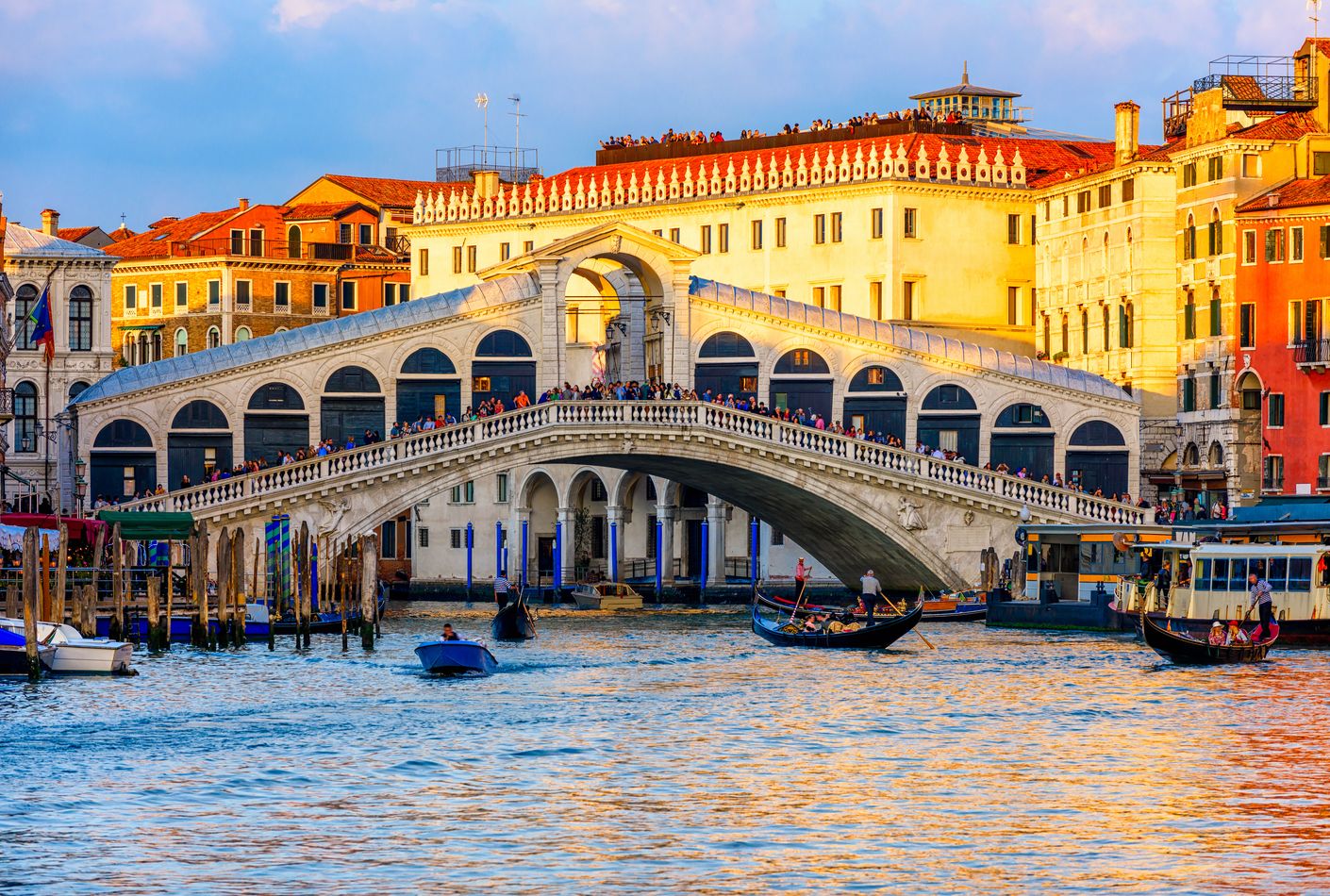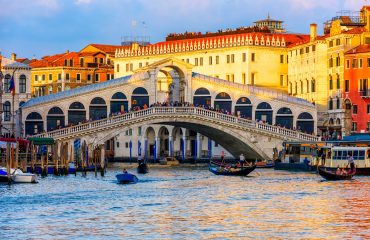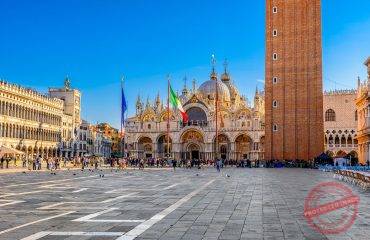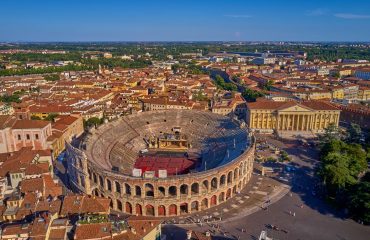
LOVE, THE LAGOON AND THE LAKE
Venice, Padua, Verona, Valpolicella & Sirmione
Starting from €12.500 (for two guests)
- Soak up the charm and magical atmosphere of Venice as you glide along the Grand Canal on a gondola
- Discover the traces of Verona’s 2,000 years of history, magnificently preserved in its urban layout and architectural treasures
- Sit down to a delicious lunch accompanied with Valpolicella wines served inside a splendid Renaissance villa
-
Duration7 days / 6 nights
-
Category
-
Day 1
Arrive in Venice
Upon arrival at the airport, meet your private driver and reach Piazzale Roma. From here a short water taxi ride will bring you to your hotel where you will be staying for 3 nights.
Following check in, which will take place after 2:00 or 3:00 PM, spend the rest of the day at leisure.
-
Day 2
Saint Mark’s Basilica, Doge’s Palace, Rialto district & afternoon gondola ride
Whether you approach this enchanting city by land or sea, your first glimpse of Venice will take your breath away. Once a powerful maritime republic which ruled supreme over Mediterranean trade routes, Venice continues to conquer visitors from far and wide drawing them into her net. Get ready for your capture on this entrancing orientation tour. Your private guide will meet you at your accommodation and lead you on a trail through Venice’s exquisite tracery of waterways and lacework facades, animated with true tales and snippets about the places you pass.
Venice is an archipelago of one hundred and eighteen tiny islands probably first inhabited by refugees escaping from nearby Roman cities, such as Padua, Treviso and Altino, during the Barbarian invasions in the 5th century AD. The city grew under the influence of Byzantium, flourished in the Middle Ages and reached the peak of its splendour during the Renaissance when it became a thriving commercial, cultural and artistic hub.
Make your way to St. Mark’s Square, once the heart of Venice’s political and religious life and today the main tourist attraction of this fabulous floating city. When you reach this wonderful piazza you will be standing in what Napoleon called “the finest salon in Europe” which does indeed appear to be a stunning hall of stone lined with remarkable historic buildings: the Basilica in all its Byzantine glory; the Renaissance clock tower proclaiming the city’s unrivalled wealth and prestige; the elegant arcades of the Procuratie; Sansovino’s ornate Loggetta; the Doge’s Palace, presiding regally over the Serenissima.
Located at the eastern end of the square, St. Mark’s Basilica was originally the doges’ personal place of worship. It was not until 1807, when it became the seat of the Patriarch of Venice, that this private chapel was converted into the city’s cathedral, and henceforth became a public marvel for all to enjoy. Step inside to hear how the construction of the building one thousand years ago was intricately bound up with a theft and the survivors of a storm at sea. The church’s magnificently decorated interior, with its marble inlays, finely carved capitals, jewel-studded altarpiece and, above all, glimmering mosaics covering 8,000 square metres of vaults and domes is an uplifting spectacle that never fails to impress.
Intriguing tales of scandal and conspiracies await you inside the Doge’s Palace, the former residence of the Venetian rulers and a feat of Gothic architecture. Follow your guide through the splendid marble courtyard, up the gold-vaulted staircase, past the doges’ private apartments into the Hall of the Great Council. Here, you will gain a better understanding of the city’s political institutions and take a close look at the priceless works of art by local painters that embellish the walls. An allegorical depiction of the Triumph of Venice by Veronese will draw your gaze to the ceiling while on the wall behind the doge’s throne you will see one of the widest canvas paintings in the world, the Paradise, created by Jacopo Tintoretto and his son Domenico between 1588 and 1592. To this duo we also owe the portraits of Venice’s first 76 doges represented on the frieze that runs beneath the ceiling. A macabre tale will explain why one of these paintings has been replaced with a black veil.
Grand monuments, graceful sculptures and decorative reliefs will amaze you as you saunter across the city’s squares and wander through its maze of narrow alleys, over fairy-tale bridges, along its celebrated canals. Busy workshops and bustling markets are as much a part of the Venetian cityscape as its elegant palazzi and pretty courtyards. A visit to the lively Rialto quarter, for almost 1,000 years the financial and commercial heart of the Serenissima, will let you feel the pulse of daily life in Venice, both past and present. Indeed from here it only takes a tiny step of the imagination to glimpse the sights and scents of exotic wares and oriental spices that merchants of old would have traded on this very spot. As you feast your eyes on brightly coloured displays of succulent, seasonal produce and a wide variety of fresh fish and seafood, your guide will paint a vivid picture of the scene in medieval times, when this site was Europe’s most important business centre.
In the afternoon, following lunch and time at leisure, reach the dock, hop aboard a gondola and soak up the charm and unique atmosphere of Venice on a magical ride with your private gondolier. While you glide along the shimmering waters of the city’s enchanting canals, the breathtaking views of the lagoon may seem like aspects of a dream… but this is a reverie come true.
After the gondola ride spend the rest of the evening at leisure.
-
Day 3
Boat trip to Murano and Burano & afternoon photo walk
Leave the tourist bustle of the city centre and sail off to explore two of the most popular Venetian islands on a half-day boat excursion. As repositories of the lagoon’s centuries-old traditions and manufacturing heritage, Murano and Burano play an essential role in your Venice experience. Don’t miss the chance to discover the history and customs of these magical islands and plunge into their timeless, dream-like atmosphere.
After breakfast meet your private guide and water chauffeur at your hotel and reach the first port of call on your lagoon excursion: Murano. Its 5,500 residents are proud guardians of the island’s long and still-thriving tradition dating back to 1291, when glass artisans were forced to move their kilns here from Venice because of fire risks. In a city of predominantly wooden buildings the profusion of glass-fusing ovens posed a constant threat. However this wasn’t the only reason that led Venice’s officials to relocate glass makers to Murano. Fear that the secrets of the trade might become known to potential rivals was just as dangerous, and possibly more so, than fires. By confining glass workers to a remote island, the republic sought to control glass production and trade and, most of all, to ensure that glass making techniques would remain a Venetian monopoly. The art of glass making helped publicise the island’s fame worldwide and it was the talented masters working here who produced the first Venetian crystal. This delicate, elegant material was highly prized and techniques of the craft were closely guarded secrets, the betrayal of which was once punishable by death. Today, however, you are free to watch glass blowers at work and see for yourself at close quarters how these Venetian craftspeople deftly pull from the furnace and model a dazzling array of splendid artefacts employing skills passed down through generations. These include wine stoppers, jewelry, vases, chandeliers and so much more.
After a pleasant walk in Murano rejoin your water chauffeur and set off for Burano, a quiet fishing village of about 2,300 residents, well known for its lace making industry. The origins of Venetian lace are lost in the mists of time. Legend has it that a fisherman went out to sea a few days before his wedding and encountered a group of mermaids while fishing. So love-stricken with his betrothed was he that the mermaids’ charms and songs failed to bewitch him. Impressed with the young man’s utter devotion, the mermaids decided to reward him with a magnificent piece of cloth embroidered by the froth of the waves. On their wedding day the fisherman gave the cloth to his delighted bride who immediately set about creating another similar piece of cloth… and that’s how the famed Burano lace was born.
Here you will admire a range of lovingly handcrafted goods including doilies, tablecloths, handkerchiefs, wedding veils and babies’ booties expertly woven by lace artisans using the same techniques as their ancestors in the 1600s, which is when Burano’s popularity spread across Europe. Intricate and beautifully stitched Burano lace creations were in high demand with nobles and royalties as attested by portrait paintings of illustrious personalities wearing outlandishly fancy lace finery. It is said that King Louis XIV wore a Burano lace collar for his coronation and the inventory of the English Queen Elizabeth I’s wardrobe provides evidence of her love of Venetian lace.
The striking polychrome homes of the islanders and the shifting hues reflected in the water are another typical feature of this uncannily beautiful spot which has long attracted landscape artists. The tradition of painting houses in highly-saturated hues may well be related to the island’s history as a fishing village. The bright colours which once helped fishermen to navigate through the fog and find their way back home are today a life-size canvas beckoning the modern visitor into the frame.
After a tranquil morning on these charming islands, you’ll be ready to cruise back to the hectic flurry of Venice again. Happy sailing!
In the afternoon, following lunch and time at leisure, click your way through Venice on a private photo walk. Under the guidance of an expert photographer you will polish your skills and capture fleeting impressions of this magical, floating city. Venice is awash with irresistible views begging to be caught through your lens. The fabulous architecture, dream-like atmosphere and ever-changing light playing on its waters make the city a treasure trove for adventurous picture seekers. Participants will have the opportunity to fine-tune their technical skills, stretch their creativity and pick up tricks for a masterly shot.
This activity can be customised to suit the needs, interests and level of expertise of all participants. Budding photographers, amateurs, veterans or curious new-comers to the art of photography will enjoy a revealing experience – whatever their knowledge – as they immortalize the unrepeatable moments of a delightful afternoon in Venice. Your photographer-tutor will explain how weather conditions can affect the quality of an image, show how diverse perspectives generate a variety of moods and feelings, teach you the basic rules of composition as well as offer encouragement to break them, when necessary, to obtain a powerful image.
You will be led past some of Venice’s most enchanting settings and, by using light as your paint brush, sketch your en plein air impressions of this ethereal city of water and stone. While you wander through the exquisite tracery of calli and picturesque campielli, across fairy-tale bridges, past lacework facades, your photographer will illuminate your path by pointing out captivating details and turning the spotlight onto the city’s lesser-known areas. From behind the lens of your camera you will glimpse off-the-beaten-path locations and peek into the city’s unique spirit. A lasting collection of Venetian memories for your holiday album is the souvenir you will take home with you.
After the experience return to your hotel and spend the rest of the day at leisure.
-
Day 4
Private transfer from Venice to Verona with a guided tour of Padua en route
After breakfast and check out your private water chauffeur will pick you up at your hotel and transport you to Piazzale Roma. From here a 45-minute drive will bring you to Padua. Your guide will be waiting at the meeting point ready to lead you on a tour of the city’s best-loved attractions.
If you trust the legend, Padua was founded in 1183 BC by prince Antenor after the fall of Troy, making it the oldest city in northern Italy. Whatever the true story, archaeological findings unearthed beneath the city centre provide evidence that prehistoric civilizations must have settled here as far back as the 11th and 10th centuries BC. The list of Padua’s feats and achievements does not end here, of course. The city is home to Italy’s second oldest university which has been a catalyst for countless generations of illustrious intellectuals and professors – including Galileo Galilei himself – since its establishment in 1222. Padua was Franciscan preacher and miracle-worker Saint Anthony’s chosen city, the place where he spent his last years and was finally laid to rest in 1231, thus triggering a wave of devotion that is very much alive today and still attracts flocks of pilgrims to the city. Padua also boasts the country’s third largest public square, the impressive 90,000 square metre Prato della Valle, graced by 78 statues featuring the city’s great and good.
But what draws thousands of visitors from far and wide to Padua every year is the city’s prized jewel, the Scrovegni Chapel. Under the tutelage of the ambitious, powerful and affluent banker Enrico degli Scrovegni, ground-breaking painter Giotto completed the decoration of the chapel’s walls in 1305, after 855 days of painstaking, meticulous labour. The breathtakingly beautiful fresco cycle depicts scenes from the Old and New Testaments and is reputed to be a milestone in the development of Western art. Your guide will point out features of particular significance and explain why this gorgeously painted Bible constitutes an artistic revolution. Indeed the only other work that bears comparison with it in terms of its impact on the contemporary scene and its influence on the history of art is Michelangelo’s Sistine Chapel. The masterful use of a brilliant palette, his realistic representation of space, perspective and light, together with the emotional intensity of his characters, break away totally from all previous artistic representations.
Padua’s charms also include bustling piazzas, porticoed streets, historical cafes and an impressive wealth of medieval and Renaissance masterpieces. Gain a preview of Paradise as you gaze up at the heavenly gathering depicted in the 14th century fresco by Giusto de’ Menabuoi on the dome of the Baptistery of Saint John. Then take in a slice of daily life as you roam through Piazza delle Erbe, the city’s commercial hub since the 11th century where the fresh fruit and vegetable market is still regularly held. The square is dominated by the imposing Palazzo della Ragione, the medieval town hall where once, as a punishment, debtors were forced to sit bare-bottomed on a stone and confess their sins before being banished from the city. And don’t forget to pay your respects to the city’s patron saint whose revered relics lie in the richly ornamented chapel behind the main altar of the 13th century Basilica of Saint Anthony. Among his many powers the saint is also believed to be the protector of all things lost… so next time you find an item that had been mislaid remember to offer up thanks to St. Anthony.
After the tour and free time for lunch rejoin your driver and reach your hotel in Verona where you will be staying for 3 nights. Following check in spend the rest of the day at leisure.
-
Day 5
Guided tour of Verona, lunch at a Renaissance villa in Valpolicella & visit to a winery
After breakfast meet your private guide in your hotel lobby and enjoy a morning walking tour of Verona’s delightful centro storico. Well known as the setting for three of Shakespeare’s plays, most importantly for the star-crossed lovers Romeo and Juliet, the city offers so much more than a romantic retreat. Here your heart may well miss a beat as you catch a glimpse of its Roman amphitheatre and gaze up at the magnificent palazzi. You may find yourself falling in love with Verona’s pretty courtyards and charming squares. Beyond the well-known fiction, there is a bustling, culturally thriving city and genuine history waiting to be explored.
Verona’s early beginnings remain a mystery but we know the area was inhabited in the 4th century BC and, thanks to its strategic geographic position as a suitable spot for northern border control, became a Roman municipium in the 1st century BC. Evidence of the city’s ancient past can still be seen in the existing street pattern that traces the Roman chess-board layout and in archaeological remains scattered throughout the city. Verona flourished under the rule of the Scaliger dynasty in the 13th and 14th centuries and continued to prosper during the almost four hundred years of Venetian domination, up until the 1700s. The surviving architectural masterpieces and urban fabric reflecting Verona’s development over 2,000 years have earned the city its status as a UNESCO World Heritage Site. A meticulously assembled collage of fine buildings and decorative elements from several historic epochs makes up the attractive historic centre. Roman ruins, Gothic monuments, medieval towers, Renaissance facades and modern-day shop windows all jostle for your attention.
Your guide will lead you through the centuries and point out the city’s best-loved landmarks. The grandiose, remarkably well-preserved Arena in Piazza Bra is one of Verona’s most impressive sights. Built in the 1st century AD, it is Italy’s third largest Roman amphitheatre and could seat up to 25,000 impassioned spectators who once gathered here to watch gladiator games and executions. The Arena, with its excellent acoustics, still draws crowds today as an entertainment venue hosting theatre performances, concerts and the internationally-renowned summer opera festival.
Another of Verona’s major attractions is located on Via Cappello. Here, according to legend, you can find the very house where Romeo swore his eternal love to Juliet. Visitors from all over the world line up to touch her bronze statue’s breast, hoping to get lucky in love, and to snap shots of the iconic balcony. Although Shakespeare is extremely unlikely ever to have set foot in this city and his characters are fictional, Verona’s fame is inextricably tied up with the destiny of the protagonists of this world-famous tragedy. The 14th century palazzo actually belonged to the Dal Cappello family, a name that sparked a link with the Shakespearian Capulet, thus lending a semblance of veracity to the legend.
A short walk will take you to picturesque Piazza Erbe, the city’s trading hub. People have assembled here since ancient Roman times, when the area was occupied by a forum. Today the square is the site of the fruit and vegetable market as well as a favourite meeting spot with young Veronesi who gather here for ritual evening aperitivi. Listen as your guide gives you details about the striking structures that surround the piazza: the arcaded portico of the medieval Casa dei Mercanti, the Mazzanti Houses, adorned with beautiful frescoes, the elaborate Baroque facade of Palazzo Maffei and the 84-metre-tall Lamberti Tower looming over the city. Not to be missed on your stroll about town are also the nearby Piazza dei Signori, the centre of Verona’s political life for hundreds of years, and the Arche Scaligere, the monumental tombs of the Lords of Verona.
After the tour your private chauffeur will pick you up and drive you to the Valpolicella wine region. The Latin etymology Val polis cellae, meaning “the valley with many cellars”, attests to Valpolicella’s ancient viticultural tradition. Extending for 240 square kilometres across the foothills of the Lessini mountains, between Verona and Lake Garda, this is one of Italy’s most prestigious wine-producing regions. Wine enthusiasts will have the opportunity to visit a highly-esteemed estate, located in an enchanting setting on the grounds of a Renaissance villa. Built at the request of humanist and landowner Giulio Della Torre in 1560, the mansion perfectly fulfilled its functions as a working farm, from which to supervise the estate’s agricultural activities, and a peaceful luxury retreat, where the owner and his privileged guests could come to meditate, relax and idle the summers away. Accompanied by a member of staff, you will explore this truly marvellous country house and learn all about the history and refined symbolism behind its construction. Highlights include the central courtyard, blending references to the design of an ancient Roman domus with a typically Mannerist taste, the hall of mirrors, decorated with original medallion portraits of poets of antiquity, and the awe-inspiring zoomorphic fireplaces featuring a lion, a sea monster and a devil. After the visit sit down inside the mansion’s dining room to be served a delicious lunch paired with the estate’s wines.
A short drive will then bring you to another renowned winery. Here, on a tour of the cellar, you will get to know about wine-making and ageing methods, become familiar with the particular features and regulations that define Valpolicella wines and discover the unique characteristics of the terroir and climate that make wines produced here so special. Top off your day with a tasting of the estate’s wines and a toast, then rejoin your chauffeur and return to your accommodation in Verona.
-
Day 6
Day trip to Sirmione, gourmet lunch & boat ride on Lake Garda
It’s time to leave the city behind and venture into the tableau of Veneto’s most popular summer resort. After breakfast meet your driver outside your hotel and relax on the ride to the lakeside town of Sirmione. Here your private guide will be waiting ready to lead you on an unforgettable tour of Lake Garda’s “pearl of the islands and peninsulas”, as celebrated by ancient Roman poet Catullus.
As you access the town over a bridge you will certainly notice the remarkably well-preserved 13th century castle, strategically perched at the edge of the lake from where it safeguards the only entrance to the old town. This rare instance of a medieval port fortification, complete with crenellated turrets and towers, was originally built by the Lords of Verona as a defence against enemy attacks and uprisings. Once a sturdy fortress designed to fend off intruders with its impenetrable walls and surrounding moat, the Castello Scaligero now beckons the visitor to step into the charming streets of Sirmione.
The area is known to have been a fashionable summer hideout since the 1st century BC, when wealthy ancient Romans retreated here, drawn by the glorious climate and healing properties of Sirmione’s thermal springs. More than 2,000 years have gone by but this timeless tourist haven keeps luring guests to its shores with a unique blend of archaeological treasures, glorious landscapes and limpid, refreshing lake waters. While you weave your way through the town’s medieval alleys, lined with tempting eateries and quaint shops, your guide will point out Sirmione’s most noteworthy features, including the late-15th century Church of Santa Maria Maggiore and its precious frescoes.
Not to be missed are the so-called Grottoes of Catullus, the most extensive and striking example of a private Roman villa in northern Italy. Today only a maze of crumbling walls and teetering stone arches survive at the tip of the peninsula, but you are invited to pause and conjure up a stirring image of the luxurious villa that must have stood on this very spot. The mansion, whose construction definitely required sophisticated engineering expertise, once featured long porticoes and terraces overlooking the lake, lavish mosaic decorations, wall paintings and even a private spa.
After the tour a gourmet meal will be served at one of Sirmione’s finest addresses, famous for its marvellous lakeside setting and exquisite fish-based tasting menus. Depending on the season, you might be treated to crispy scampi and seabass seasoned with lemon and chive, tortelli with gorgonzola, Breton lobster and walnuts, baked Morone fish dressed with roast meat sauce… Buon appetito!
Next, meet your skipper at the dock and soak up the wonderful scenery of Lake Garda on a private boat ride. Here natural beauty and architectural marvels merge perfectly, creating one of Italy’s finest landscapes. As you glide along the rippling waters, take in the breathtaking sights of deep green slopes, elegant villas and the pastel-hued towns that pepper the lake’s shoreline.
In the afternoon your private chauffeur will be waiting at the parking area ready to drive you back to Verona where you will spend the rest of the day at leisure.
-
Day 7
Arrivederci Verona!
After breakfast and check out, which will take place before 10:00 or 11:00 AM, meet your private driver outside your hotel and head for the airport, train station or your next travel destination.
- Three nights at a 4-star or 5-star hotel in Venice (breakfast included)
- Three nights at a 4-star or 5-star hotel in Verona (breakfast included)
- Private chauffeured transfers and car services with luxury vehicles, as per programme
- Private water taxi services, as per programme
- Private tours with expert licensed guides, as per programme
- Entrance tickets to museums and sites, as per programme
- Meals, as per programme
- A private gondola ride with a gondolier
- A visit to a glass blowing factory or atelier in Murano
- A half-day private photo walk with an expert photographer
- A visit to a villa in Valpolicella with wine tasting and lunch
- A visit to a winery in Valpolicella with wine tasting
- A 1-hour 30-minute private boat ride on Lake Garda
- Full support from your travel designer before, during and after your trip
- City tax to be paid directly at the hotels
- Meals, other than those listed in the programme
- Tips
- This vacation is entirely customisable and can be tailored to suit your needs and preferences. The experiences featured in this trip give an idea of what we can arrange for you but you may modify the itinerary as you wish. You may include additional tours, remove activities that are not of interest to you, replace an activity with another one from our collection of recommended experiences, or ask us to create personalised experiences to meet your specific requests
- The order of the sites visited may change depending on your exact travel dates
- All experiences are subject to availability
- Although pre-booked tickets for St. Mark’s Basilica and the Doge’s Palace will be provided, visitors will still have to pass through security points and therefore might have to wait in line
- Remember to bring your own camera for the photo walk
- When visiting churches and sacred sites, clothing should be appropriate for a sacred place. Shoulders and knees must be covered
- Please advise of any food allergies or intolerances





